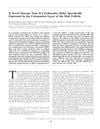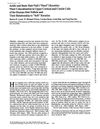63 citations
,
July 2006 in “British Journal of Dermatology” Psoriasis causes changes in certain keratins and shrinks sebaceous glands in the scalp.
86 citations
,
May 2002 in “Journal of Investigative Dermatology” A new keratin, hK6irs1, is found in all layers of the hair follicle's inner root sheath.
38 citations
,
October 2001 in “British Journal of Dermatology” Keratin K6irs is a marker for the inner root sheath of hair follicles in mice and humans.
272 citations
,
September 2001 in “Journal of Biological Chemistry” Human hair keratins were cataloged, showing their roles in hair differentiation stages.
101 citations
,
August 2001 in “The Journal of Cell Biology” A new keratin 6 type in mice explains why some mice without certain keratin genes still have normal hair and nails.
 98 citations
,
June 2001 in “Journal of biological chemistry/The Journal of biological chemistry”
98 citations
,
June 2001 in “Journal of biological chemistry/The Journal of biological chemistry” A cluster of sulfur-rich hair protein genes was found on chromosome 17.
45 citations
,
March 2001 in “Journal of Investigative Dermatology” 41 citations
,
January 2001 in “Journal of Investigative Dermatology” 77 citations
,
March 2000 in “Journal of Investigative Dermatology” 235 citations
,
July 1999 in “Journal of biological chemistry/The Journal of biological chemistry” Human hair is made up of different keratins, some strong and some weak, with specific types appearing at various stages of hair growth.
 139 citations
,
December 1998 in “The journal of investigative dermatology/Journal of investigative dermatology”
139 citations
,
December 1998 in “The journal of investigative dermatology/Journal of investigative dermatology” K6hf is a unique protein found only in a specific layer of hair follicles.
61 citations
,
February 1997 in “Differentiation” 52 citations
,
October 1995 in “Experimental Cell Research” 44 citations
,
August 1990 in “PubMed” Keratins K1 and K10 are found in the inner root sheath and cuticle of human hair follicles.
198 citations
,
November 1989 in “The Journal of Cell Biology” The study examined the expression of keratin K14 in human skin, particularly in the epidermis and hair follicles, using monospecific antisera and cRNA probes. It was found that K14 expression and filament organization differed significantly between the hair follicle and epidermis. In the outer root sheath (ORS) cells, which are mitotically active, K14 expression was low, and keratin filaments were fewer and more loosely organized compared to basal epidermal cells. As ORS cells differentiated, they increased K14 expression and formed denser keratin bundles. In contrast, matrix cells, which can differentiate into the inner root sheath, cuticle, and hair shaft, did not express K14 or form keratin filaments. Instead, they produced hair-specific keratins and dense filament bundles without inducing K14 expression. The study suggested that the patterns of K14 expression and filament organization in skin epithelial cells were linked to their pluripotency and highlighted the distinct differentiation programs of hair follicles compared to other stratified squamous epithelia.
156 citations
,
January 1989 in “Genes & Development” The study investigated keratin and keratin mRNA expression during the differentiation of stem cells into epidermis and hair follicles, as well as follicle morphogenesis. It found that type I keratin K14 was expressed early in embryonal basal cells and elevated in the basal layer of developing epidermis, but suppressed in developing matrix cells, indicating a biochemical distinction between diverging cell types. This expression pattern suggested a narrow developmental window for irreversible divergence in basal and matrix cells. In contrast, a hair-specific type I keratin was expressed late in hair matrix development, indicating that keratin expression might be a consequence of cell organization and differentiation rather than a cause.
187 citations
,
May 1988 in “Differentiation” 248 citations
,
April 1988 in “Differentiation” 135 citations
,
November 1987 in “Differentiation”  356 citations
,
December 1986 in “The journal of cell biology/The Journal of cell biology”
356 citations
,
December 1986 in “The journal of cell biology/The Journal of cell biology” Hair and nail cells share similar proteins, indicating a common differentiation pathway.


